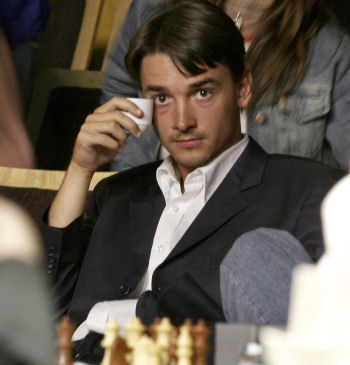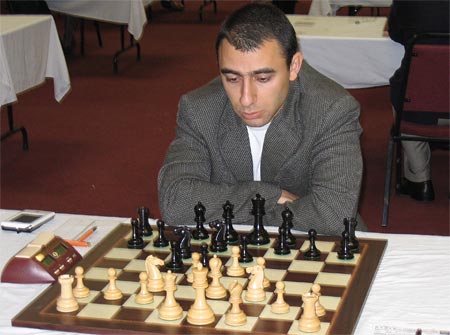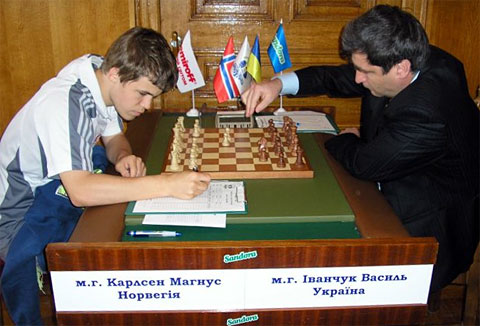| Latest | Greatest | Lobby | Journals | Search | Options | Help | Login |
|
|
|
This topic is archived. |
| Home » Discuss » Topic Forums » Sports |
|
| Jack Rabbit
|
Wed Jun-04-08 10:57 PM Original message |
| The Jack Rabbit Chess Report (June 4): Morozevich takes Sarajevo |
|
Morozevich storms the field in Sarajevo
Gramdmaster Alexander Morozevich of Russia, who may rise to number three in the FIDE rankings due out at the end of this month, won the annual international tournament sponsored by the Bosna Chess Club of Sarajevo with 7½ points out of ten rounds in competition completed Sunday. Morozevich finished a point and a half ahead of his nearest rivial, Cuban grandmaster Lenier Domínguez, the highest ranking Latin American player. Moro, as he is known to his fans, came into the final round already assured of a clear first prize. Three-way tie in Chicago Open American grandmasters Var Akobian and Hikaru Nakamura and Armenian GM T. L. Petrosian tied for first place with 5½ points out of seven rounds in the Chicago Open completed May 26. The two top finishers by tie break point, Akobian, who hails from Armenia, and Petrosian, played a blitz playoff that came down to an Armageddon Game, which was won by Akobian. Calendar This week: The National Open in Las Vegas, Nevada, begins Friday. The top seed is US grandmaster Gata Kamsky. The third annual Aerosvit International Tournament, Foros, Ukraine begins Sunday and runs 11 rounds through June 19. This years participants are Magnus Carlsen (Norway), Peter Svidler (Russia), the red-hot Vassily Ivanchuk (Ukraine), Alexei Shirov (Spain), Sergey Karjakin (Ukraine), Dmitry Jakovenko (Russia), Evgeny Alexseev (Russia), Pavel Eljanov (Ukraine), Andrei Volokitin (Ukraine), Liviu-Dieter Nisipeanu (Romania), Loek van Wely (Holland) and Alex Onischuk (United States). Ivanchuk won last year's event with 7½ points, a half-point ahead of Karjakin. |
| Printer Friendly | Permalink | | Top |
| Jack Rabbit
|
Wed Jun-04-08 10:59 PM Response to Original message |
| 1. Games of the Week |
|
Special assistant to Mr. Rabbit for game analysis is Fritz 6.0. Diagrams on the Jack Rabbit Chess Report are made with Chess Mérida, a true type font that can be downlaoded free here. !""""""""# $tMvWlVmT% $OoOoOoOo% $ + + + +% $+ + + + % $ + + + +% $+ + + + % $pPpPpPpP% $RnBqKbNr% /(((((((() WHITE White to move (This position is a theoretical draw) |
| Printer Friendly | Permalink | | Top |
| Jack Rabbit
|
Wed Jun-04-08 11:00 PM Response to Reply #1 |
| 2. Morozevich - Movsesian, Round 3, Sarajevo |
 Alexander Morozevich Alexander Morozevich - Sergei Movsesian Bosnia Sarajevo Tournament, Round 3 Sarajevo, 25 May 2008 Slav Queen's Gambit: Chameleon Defense 1.d4 d5 2.c4 c6 3.Nc3 Nf6 4.Nf3 a6
5.e3
5...b5 6.c5
6...Nbd7
7.Bd2
7...a5 8.Rc1!?
8...Ba6!
9.a3
9...Qc7
10.b4
10...axb4 11.axb4 g6 12.Bd3 Bg7 13.0-0 0-0
14.Ne2 Bb7 15.h3!?
15...Ra3
16.Bc3 Rfa8 17.Bb2
17...R3a6 18.Qb3 Ne8 19.Rfe1!?
19...e5 20.e4 dxe4 21.Bxe4 Ndf6?!
22.Ng3 exd4 23.Nxd4 Rd8
24.Bf3 Raa8
!""""""""# $t+ Tm+l+% $+vW +oVo% $ +o+ Mo+% $+oP + + % $ P N + +% $+q+ +bNp% $ B + Pp+% $+ R R K % /(((((((() WHITE: Alexander Morozevich Position after 24...Ra6a8 25.Ndf5!?
25...gxf5 26.Nxf5 Rd7 27.Nxg7!
27...Kxg7 28.Qc3
28...Qf4
29.Re4 Qd2 30.Qe5!
30...Ra2?
31.Re2 Qh6
!""""""""# $ + +m+ +% $+v+t+oLo% $ +o+ M W% $+oP Q + % $ P + + +% $+ + +b+p% $tB +rPp+% $+ R + K % /(((((((() WHITE: Alexander Morozevich Position after 31...Qd2h6 32.Rce1!
32...Rxb2
33.Qxb2 Nc7 34.Bg4
34...Rd3
35.Re7 Ncd5 36.Rxb7 Rd2 37.Qe5 1-0
|
| Printer Friendly | Permalink | | Top |
| Jack Rabbit
|
Wed Jun-04-08 11:01 PM Response to Reply #1 |
| 3. Akobian - Zapata, Round 7, Chicago |
 Var Akobian Var Akobian - Alonso Zapata Open Tournament, Round 7 Chicago, 26 May 2008 West India Game: King's Indian Defense (Sämisch Opening) 1.d4 Nf6 2.c4 g6 3.Nc3 Bg7 4.e4 d6 5.Bg5
5...h6 6.Bh4 0-0 7.Bd3 e5!?
8.d5 a5
9.f3 Na6 10.Nge2 Qe8!?
11.Qd2
11...Nh5
12.Bf2
12...f5 13.exf5 gxf5 14.0-0-0 Nc5
15.Bc2?!
15...e4?
16.Rde1 Bd7
!""""""""# $t+ +wTl+% $+oOv+ V % $ + O + O% $O +p+o+m% $ +p+o+ +% $+ N +p+ % $pPbQnBpP% $+ K R +r% /(((((((() WHITE: Var Akobian Position after 16...Bc8d7 17.Bd4!
17...Qg6
18.Bxg7
18...Qxg7
19.fxe4 fxe4 20.Nxe4
20...a4
!""""""""# $t+ + Tl+% $+oOb+ W % $ + O + O% $+ Op+ +m% $o+p+n+ +% $+ + + + % $pPbQn+pP% $+ + R +r% /(((((((() WHITE: Var Akobian Position after 20...a5a4 21.Qd4!!
21...Nxe4 22.Qxg7+ Nxg7 23.Bxe4 b5
24.cxb5 Bxb5 25.Nc3 Bc4
26.Bf3 a3 27.b3 Ba6 28.Re4 Bd3
29.Rd4
29...Bg6 30.Kd2
30...Ne8 31.Re1 Nf6
32.Re7 Rf7 33.Rxf7 Bxf7 34.Ra4
34...Rxa4 35.bxa4 Nd7 36.a5 Nc5 37.Be2
|
| Printer Friendly | Permalink | | Top |
| Jack Rabbit
|
Wed Jun-04-08 11:03 PM Response to Reply #1 |
| 4. Becerra - Shulman, US Championships, Round 7, Tulsa |
 Yury Shulman Julio Becerra - Yury Shulman US Championships (General Competition), Round 7 Tulsa, 19 May 2008 Closed French Game: Winawer Defense 1.e4 e6 2.d4 d5 3.Nc3 Bb4 4.e5 c5 5.a3 Bxc3+ 6.bxc3 Ne7 7.Qg4
7...cxd4
8.Qxg7 Rg8 9.Qxh7 Qc7 10.Ne2
10...Nbc6 11.f4 Bd7 12.Qd3 dxc3 13.Nxc3
13...a6 14.Rb1 Na5
15.h4 Nf5 16.Rh3 0-0-0 17.h5 Nc4 18.Rb4
18...Bc6 19.Ne2 Bb5 20.a4 Qc5 21.Ba3
21...Bc6 22.Qc3 !""""""""# $ +lT +t+% $+o+ +o+ % $o+v+o+ +% $+ WoPm+p% $pRm+ P +% $B Q + +r% $ +p+n+p+% $+ + Kb+ % /(((((((() WHITE: Julio Becerra Position after 22.Qd3c3 22...Rg4!
23.h6 Rh8 24.h7 Rg7
25.Rb3 Qa7
26.Bc1 Bxa4 27.Qb4? !""""""""# $ +l+ + T% $Wo+ +OTp% $o+ +o+ +% $+ +oPm+ % $vQm+ P +% $+r+ + +r% $ +p+n+p+% $+ B Kb+ % /(((((((() WHITE: Julio Becerra Position after 27.Qc3b4
27...b5!
28.Rh5
28...a5 29.Qc3 Rgxh7 30.Rxf5
30...exf5 31.Qd3 Qc5 32.Nc3 Rh5 33.Nxa4
33...bxa4 34.Rc3
34...Kb8 35.Ba3
35...Qb5 36.Kf2 Rh1 37.Bd6+ Kb7 38.Be2
38...Qb6+ 39.Kg3
!""""""""# $ + + + T% $+l+ +o+ % $ W B + +% $O +oPo+ % $o+m+ P +% $+ Rq+ K % $ +p+b+p+% $+ + + +t% /(((((((() WHITE: Julio Becerra Position after 39.Kf2g3 39...R1h3+!! 0-1
|
| Printer Friendly | Permalink | | Top |
| Jack Rabbit
|
Wed Jun-04-08 11:08 PM Response to Reply #1 |
| 5. Abrahamyan - Jamison, US Championships, Round 7, Tulsa |
|
Tatev Abrahamyan, a teenager born in Armenia, won the Fighting Chess Award from the website GoddessChess.com for her aggressive play in Tulsa.
 Tatev Abrahamyan Tatev Abrahamyan - Courtney Jamison US Championships (Women's Competition), Round 7 Tulsa, 19 May 2008 Open Sicilian Game:Taimanov Defense (Szen Opening) 1.e4 c5 2.Nf3 Nc6 3.d4 cxd4 4.Nxd4 Nf6 5.Nc3 e6 6.Ndb5
6...Bb4
7.a3 Bxc3+ 8.Nxc3 d5 9.exd5 exd5 10.Bd3 0-0 11.0-0 Be6
12.Bg5 h6 13.Bh4 Ne5 14.Re1 Ned7!?
!""""""""# $t+ W Tl+% $Oo+m+oO % $ + +bM O% $+ +o+ + % $ + + + B% $P Nb+ + % $ Pp+ PpP% $R +qR K % /(((((((() WHITE: Tatev Abrahamyan Position after 14...Ne5d7 15.Nb5
15...Qb6 16.a4 a6
17.a5 Qc5
18.Nd4 Bg4
19.Qd2 Rfe8 20.b4
20...Qc7 21.f3 Bh5 22.Nf5 Rad8
23.Bg3 Ne5 24.Re2 Re6 25.Rae1 Rde8
!""""""""# $ + +t+l+% $+oW +oO % $o+ +tM O% $P +oMn+v% $ P + + +% $+ +b+pB % $ +pQr+pP% $+ + R K % /(((((((() WHITE: Tatev Abrahamyan Position after 25...Rd8e8 26.Nxh6+!
26...gxh6 27.Qxh6!!
27...Qc3
28.Qg5+ Ng6
29.Rxe6 Rxe6 30.Rxe6 fxe6 31.Bxg6 Bxg6 32.Qxg6+ Kh8 33.h4 Qd4+ 34.Kh2 Qc3 35.h5 1-0
|
| Printer Friendly | Permalink | | Top |
| Jack Rabbit
|
Thu Jun-05-08 09:01 PM Response to Reply #1 |
| 6. Friedel - Gulko, US Championships, Round 4, Tulsa |
|
Josh Friedel earned his third grandmaster norm in Tulsa and is on track to be officially name an International Grandmaster by FIDE later this year.
Congratulations, Josh. Josh Friedel Josh Friedel - Boris Gulko US Championships (General Competition), Round 4 Tulsa, 16 May 2008 Spanish Petit Royal Game: Neo-Classical Defense 1.e4 e5 2.Nf3 Nc6 3.Bb5 Bc5
4.0-0
4...Nf6
5.c3 0-0 6.d4 Bb6 7.Bg5
7...h6 8.Bh4 d6 9.Qd3 exd4
10.cxd4
10...g5 11.Bg3 d5
12.exd5!?
12...Nxd5
13.Nc3
13...Ndb4 14.Qe4
14...f5 15.Qe2
15...f4 16.Qc4+ Kg7 17.d5 fxg3 !""""""""# $t+vW T +% $OoO + L % $ Vm+ + O% $+b+p+ O % $ Mq+ + +% $+ N +nO % $pP + PpP% $R + +rK % /(((((((() WHITE: Josh Friedel Position after 17...fg3:B 18.hxg3!
18...Nc2 19.dxc6!
19...Nxa1 20.Rd1
20...Qf6 21.Ne4
21...Be6
22.Rd7+ Rf7?
23.Nxf6
23...Bxc4 24.Nh5+
24...Kf8 !""""""""# $t+ + L +% $OoOr+t+ % $ Vp+ + O% $+b+ + On% $ +v+ + +% $+ + +nP % $pP + Pp+% $M + + K % /(((((((() WHITE: Josh Friedel Position after 24...Kg7f8 25.cxb7!
25...Rb8 26.Ne5 Bxf2+ 27.Kh2 Re7 28.Bxc4 1-0
|
| Printer Friendly | Permalink | | Top |
| Jack Rabbit
|
Sat Jun-07-08 12:19 PM Response to Reply #1 |
| 7. Domínguez - Wojtaszek, Capablanca Memorial, Round 1, Havana |
|
Edited on Sat Jun-07-08 12:37 PM by Jack Rabbit
After a delay, the games of the 43rd Capablanca Memorial Tournament are now available.
The event was won by Cuban grandmaster Lenier Domínguez, who is now poised to become the first Latin American player to pass 2700 mark on the FIDE ratings list due out at the end of June. ¡Las felicitaciones para el señor Domínguez!  Lenier Domínguez Lenier Domínguez - Radoslaw Wojtaszek Capablanca Memorial Tournament, Round 1 Havana, 8 May 2008 Open Sicilian Game: Najdorf-Boleslavsky Defense (Chandler-Nunn Opening) 1.e4 c5 2.Nf3 d6 3.d4 cxd4 4.Nxd4 Nf6 5.Nc3 a6 6.Be3 e5
7.Nb3
7...Be7
8.f3
8...Be6 9.Qd2 0-0 10.0-0-0 a5 11.a4
11...Na6
12.g4 Nb4 13.Kb1 Qc7!?
14.g5
14...Nd7 15.f4
15...exf4 16.Bxf4 Ne5?
17.Nd4 Bg4 18.Be2
18...Nc4
!""""""""# $t+ + Tl+% $+oW VoOo% $ + O + +% $O + + P % $pMmNpBv+% $+ N + + % $ PpQb+ P% $+k+r+ +r% /(((((((() WHITE: Lenier Domínguez Position after 18...Ne5c4 19.Bxc4!!
19...Bxd1
20.Bb3!
20...Bh5 21.Nf5
21...Rfe8 22.Qd4!
22...Bf8
!""""""""# $t+ +tVl+% $+oW +oOo% $ + P + +% $O + +nPv% $pM QpB +% $+bN + + % $ Pp+ + P% $+k+ + +r% /(((((((() WHITE: Lenier Domínguez Position after 22...Be7f8 23.Bxd6!!
23...Qd8
24.Nd5
24...Nc6 25.Qc3 Qxg5 26.Bxf8 Rxf8 27.Nf4 Bf3
28.Qxf3 Ne5 29.Qf2 g6 30.Rg1 Qd8 31.Qc5 Nf3 32.Qc3 1-0
|
| Printer Friendly | Permalink | | Top |
| Jack Rabbit
|
Sun Jun-08-08 10:59 PM Response to Reply #1 |
| 8. Weeramantry - Petrosian, National Open, Round 1, Las Vegas |
|
Tigran Levon Petrosian is no relation to the late former world champion, Tigran Vartanovich Petrosian. The younger man was born in Armenia a few days after the former champion's death in 1984 and named in his honor.
T. L. Petrosian Sunil Weeramantry - T. L Petrosian National Open, Round 1 Las Vegas, 6 June 2008 Closed Sicilian Game: Grand Prix Opening 1.e4 c5 2.Nc3 Nc6 3.f4
3...g6 4.Nf3 Bg7 5.Bc4
5...e6 6.f5 Nge7 7.fxe6 dxe6
8.d3 h6
9.0-0 a6!?
10.a4
10...b6 11.Qe1 g5 12.Qg3
12...Ng6
13.Be3 Bb7 14.h3?! !""""""""# $t+ Wl+ T% $+v+ +oV % $oOm+o+mO% $+ O + + % $p+b+p+ +% $+ NpBnQp% $ Pp+ +p+% $R + +rK % /(((((((() WHITE: Sunil Weeramantry Position after 14.h2h3
14...Qb8!?
15.Qg4
15...Qd6
16.Nd2 Nd4 17.Qh5?
!""""""""# $t+ +l+ T% $+ + +oV % $oO Wo+mO% $+ O + Oq% $p+bMp+ +% $+ NpB +p% $ PpN +p+% $R + +rK % /(((((((() WHITE: Sunil Weeramantry Position after 17.Qg4h5 17...Nxc2!
18.Rxf7
18...Kxf7 19.Rf1+ Bf6 20.e5 Qxe5 21.Nde4
21...Nxe3 22.Rxf6+ Qxf6 23.Nxf6 Kxf6 24.Qe2
24...Nxc4 25.dxc4 Rad8 26.a5 Nf4 0-1
|
| Printer Friendly | Permalink | | Top |
| Jack Rabbit
|
Mon Jun-09-08 09:22 AM Response to Original message |
| 9. Update: Monday, June 9 |
|
Edited on Mon Jun-09-08 09:25 AM by Jack Rabbit
Magnus defeats Ivanchuk in opening round at Foros
 Top seed Magnus Carlsen of Norway defeated Ukrainian grandmaster Vassily Ivanchuk, who is probably the hottest chess master during the Spring of 2008, in the opening round of the third annual Aerosvit International Tournament in the Crimean town of Foros, Ukraine, yesterday. The game went 46 moves. Magnus played White. Ivanchuk met the seventeen-year-old's 1.d4 with a King's Indian Defense. In the day's only other decisive game, Latvian-born grandmaster Alexei Shirov of Spain, playing Black, defeated former Dutch champion Loek van Wely in 41 moves. National Open ends in six-way tie  The 2008 National Open in Las Vegas, Nevada, a six-round affair played over three days, finished in a six-way tie for first prize last night. The six are: Gata Kamsky, the leading American grandmaster; US grandmaster-elect Josh Friedel; Laurent Fressinet of France; T. L. Petrosian of Armenia; Bulgarian GM Atanas Kolev; and American GM Ben Feingold. Kamsky and Friedel entered the final round tied for first place on 4½ points apiece. The two fought hard against each other for 59 moves before agreeing to a draw. Eight players began the final round tied for third at 4 points each, with each of those contestants playing one other; all four game were decisive and the winners joined Kamsky and Friedel at the top. |
| Printer Friendly | Permalink | | Top |
| DU
AdBot (1000+ posts) |
Sat Apr 20th 2024, 05:42 AM Response to Original message |
| Advertisements [?] |
| Top |
| Home » Discuss » Topic Forums » Sports |
|
Powered by DCForum+ Version 1.1 Copyright 1997-2002 DCScripts.com
Software has been extensively modified by the DU administrators
Important Notices: By participating on this discussion board, visitors agree to abide by the rules outlined on our Rules page. Messages posted on the Democratic Underground Discussion Forums are the opinions of the individuals who post them, and do not necessarily represent the opinions of Democratic Underground, LLC.
Home | Discussion Forums | Journals | Store | Donate
About DU | Contact Us | Privacy Policy
Got a message for Democratic Underground? Click here to send us a message.
© 2001 - 2011 Democratic Underground, LLC